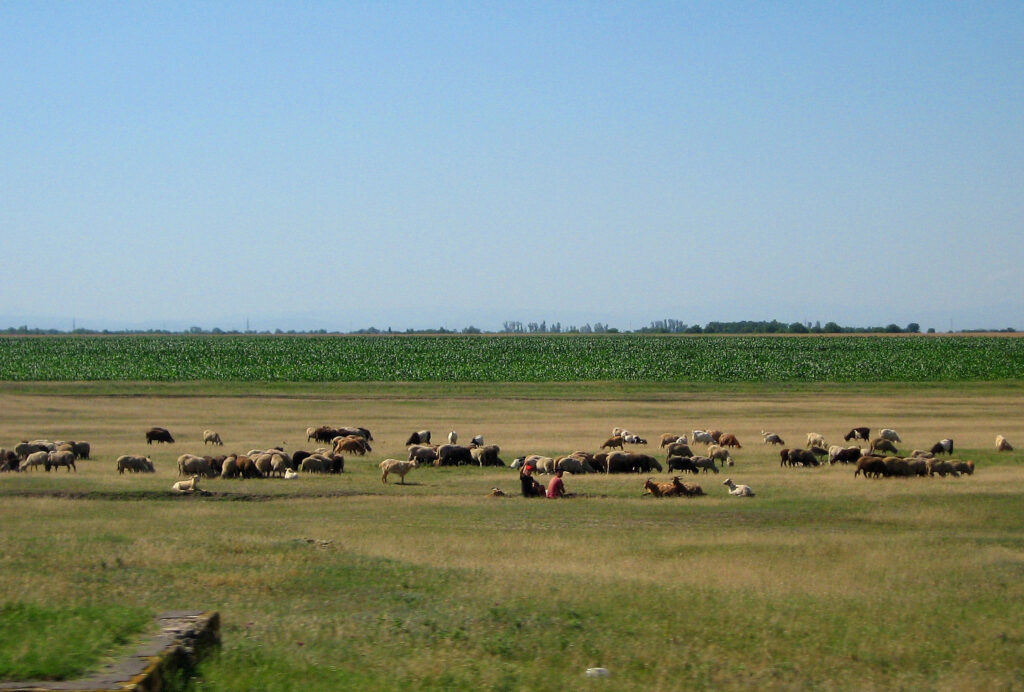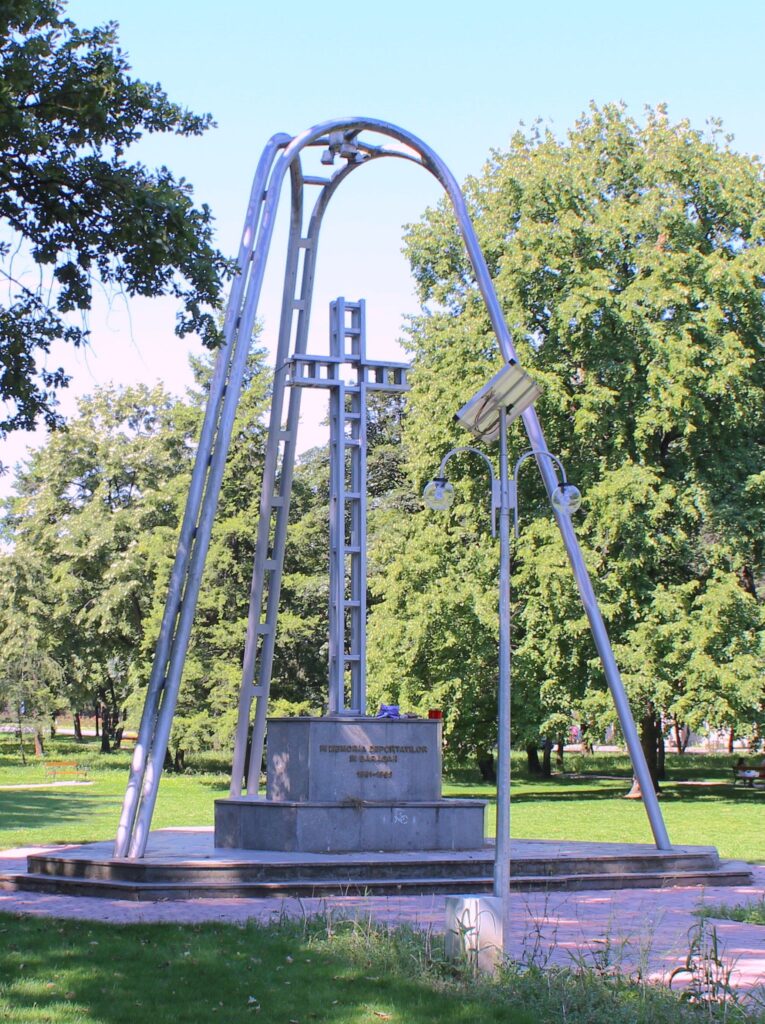Maria Gabriela Groza
Context
The Bărăgan deportations represented the Romanian Communist regime’s decision in the 1950s to relocate approximately 44,000 people who lived near the Romania–Yugoslavia border. This massive number of people – from infants to nonagenarians – was relocated to the Bărăgan Plain, where they had to rebuild their families and lives in the 18 new villages that were established there.
For a better understanding of this deportation to the Bărăgan Plain, we will approach the following subjects and questions: How did the dislocation measure became a law that targeted hostile elements? What were the main problems within the 18 new established villages? What rights and limits did the deportees have within the new areas? What was the relation between the working conditions and the schooling system?
The deportation to Bărăgan was just one of the Romanian Communist leaders’ official state reactions the to the Tito–Stalin split. The conflict emerged in the Soviet bloc in 1948, when the Yugoslav leader Josip Broz Tito had the idea of creating a Balkan Alliance, which would consist of three states: Yugoslavia, Bulgaria and Albania. From the perspective of Joseph Stalin, the Soviet leader, this small alliance potentially threatened Moscow’s future hegemony over its satellite states.
State Reaction
From the first signs of conflict until 1951, several debates that have been documented and archived developed the idea of forcibly removing so-called Tito followers from the border area. Initially, around 732 people were targeted for dislocation, but over time this increased to a total of 44,000 by the spring of 1951 from the counties of Timis, Caras-Severin and Mehedinti, in total 30 localities near the border with Yugoslavia. The deportation to the Bărăgan Plain recomposed the communities in 18 new villages: Viișoara, Olaru, Dâlga, Fundata, Dropia, Pelicanu, Ezeru, Salcâmi, Răchitoasa, Movila Gâldăului, Valea Viilor, Lătești, Măzăreni, Zagna, Bumbăcari, Schei, Brateș și Rubla.
The deportation to the Bărăgan Plain mainly affected three categories of people: 1. citizens of the Western states, including those who had Yugoslav citizenship; 2. citizens from Bessarabia and Northern Bukovina; 3. citizens that had Macedonian origins, and other categories. The last other elements category, which is the most general, included members of the German ethnic group, direct relatives of Romanian illegal fugitives, people who were in contact with members of the armed resistance, and those who had been previously sentenced for political reasons or crime.
The night round-up
From the night of deportation we have multiple victims’ testimonies that recreate the context and the general picture of the events. One voice that we want to highlight is that of Ștevin Silvestru, who remembers this episode in his bookBărăgan – 1951. Dislocation. Resettlement. Deportation:
I heard it while I was sleeping: angry knocking at the big gate, our dog Băla barking, and someone shouting and throwing hard objects in the window. (…) I looked out of the street-facing window and I see armed military people. I freeze. They will shoot us. I get a heavy feeling in my stomach and a wave of heat goes up towards my head, making my cheeks feel like they are burning. (…) In two hours it is mandatory for us to leave our belongings and household: they are confiscated. Maybe forever? (…) We are told that we will be taken to the train station and will leave this area. But to where?
Ștevin Silvestru, nine and a half years old at the moment of deportation
They had only a couple of hours to gather their basic belongings under the constant, close monitoring of the authorities, who had the sole aim of making sure no one would try to escape. There was a profound fear of being deported to Siberia, and with that thought in their minds the people packed the basics: clothes, food, and household objects they could take on the train. The deportees’ families were also allowed to take with them a few livestock, such as a sheep, a cow, and a horse to pull a carriage. These belongings that were taken to Bărăgan varied depending on what the targeted people had been assigned to do there. It is important to underline that these ‘state enemies’ included Bessarabians and Bukovinians who had escaped from the war zone between 1939 and 1940. Hence, their fear of deportation to Siberia was even greater. Transporting the deported population was done with the direct assistance of the Ministry of Transport, which provided trains, especially freight wagons and lorries.
In the evening we are all in the wagons, under strict guard, and just then we realize how tired, hungry and thirsty we all are. You cannot leave the village under any circumstances. Here, in the train station, we see all the so-called “state enemies”, taken by force from the villages. The train – “a long snake” of over 60 wagons – does not fit in the station. The conductor is constantly moving it along the tracks to make room for normal scheduled trains.

A new place: nowhere to start
Once they arrived at the Bărăgan Plain, the deportees were assigned to lands held by the State Agricultural Farms in Galați and Ialomița. No one was allowed to travel more than a radius of 15 kilometres from the place where they were initially assigned. Exceptions were applied for those who had work certificates and could justify transit beyond this area.
It is important to underline Ștevin Silvestru’s statement about the new home universe that ended at the spiked metal fences that were used to delimitate the families’ prearranged plots.
This landmark gives us children a sense of security when we leave the building to explore the area with an eye toward returning “home”. It protects our property. Around it our life will take place from now on for a long time – the life of those who will create the new village.
Left on the plains, the people had very few resources to build houses, so they had to make do with huts. The Romanian Working Party imposed standards for the communities in order to develop the institutional buildings alongside their improvised houses. In each of the 18 villages, a Provisional Committee was created in order to plan the building work. The construction standards were based on individual production quotas of mudbricks – the main material used alongside wood. Besides the Provisional Committees, there were also Communal Commissions, which comprised party activists, militia agents, representatives of the State Agricultural Farms, and foreman supervisors for the construction plans.
Adult responsibilities for children
By autumn, the deportees had managed to improvise houses with mud walls; they also worked in the community for elders who needed help establishing new homes and could not achieve the daily mudbrick quota. Some buildings were finished faster, especially the institutional ones: dispensaries, schools, militia and local authorities’ headquarters, and general stores. The workers who were allowed beyond the 15-kilometre limit were involved in the activities of the State Agricultural Farms and collective work in nearby villages. Each mudbrick quota was assigned jointly to four or five families, children included, working in shifts. Building of institutional buildings was considered volunteer work, with duties being assigned to family members depending on their age and labour power.
Mudbricks were the main construction material, but timber, provided by the state, and straw were also used. The state gave clear regulations regarding the depth of the foundations and the height of the buildings and houses, and food rations were given to the deportees during working hours. Ștevin Silvestru mentions that the meal rations varied. In the morning they were served with a quarter of a loaf of brown bread or polenta with tea; for lunch, they had another a quarter of a loaf of bread with vegetable soup, potato stew, and either baked beans or unwashed pearl barley; in the evening they had polenta or macaroni with cheese, or sometimes, as dessert, macaroni with marmalade, varying from village to village.
Limits of the educational system
The educational system in Bărăgan from 1951 was run by teachers or high-school graduates from within the deportee community. The school buildings had the same basic structure as the rest of the so-called institutions of power in Bărăgan: mudbricks, woodwork and straw. In some cases, the ceiling was covered with tiles, but reed was more common. In terms of meaning, values and the curriculum, school changed radically for the deported children, who were not allowed to go more than 15 kilometres from their village, therefore their opportunities for further learning were also limited. They were isolated and some of them were not able to continue their studies after deportation because the educational system had no resources for their specific educational needs.
School started after 15th of September, from what I remember, in a sort of a festive way that opened the year 1951–1952. Anyhow, it started! I was enrolled in the 3rd grade. For us, this was a precarious educational system because of the material conditions in which we had to learn, but this was supplemented by the eagerness and devotion of our teachers, who made us what we are today.
From a financial point of view, the resources that were given to the schools were not enough, hence people from inside the community volunteered to maintain the school during the summer and winter and managed to find suitable furniture for the classrooms in the community. Unfortunately, the logistics of the Bărăgan schools were mostly suited to the elementary stage: as Ștevin Silvestru recalls, pupils who had finished the seventh grade could not progress to the 8th grade because they had to leave the village for this, which was forbidden.
This situation was overcome a few years later, when these pupils could somehow be assimilated into the grading system at a national level. They still had no official educational support, but instead they were examined by teachers who were brought to the school for this purpose. However, their regular teachers strived to prepare them for the exams and provide them with the materials and education they needed.
The Bărăgan children’s childhoods were mostly defined by educational methods and the mandatory tasks their families had to perform to meet their quotas – on the farm, in the fields, or picking cotton with their small hands. We can see that their history is marked by hard work alongside their parents, and in many cases the children had to keep the household together while their parents were outside the community with special working permits.

A life in perpetual transition
The destiny of the deportees – both adults and children – was marked by a constant process of starting over. After 1955, when the restrictions were lifted, many left the villages they had created behind with the hope that back in Banat they would be able to get back to their normal lives. Unfortunately, the majority of their houses had been nationalized and thus were now dispensaries, general stores or headquarters of state institutions. Some deportees were able to reclaim their homes, but only after lengthy legal proceedings. On the other hand, some groups decided to live in villages near their new villages on the Bărăgan Plain and continue their lives there because they either had nothing to return to or they had become comfortable living there. The history of the Bărăgan families is unique – mostly dominated by fear of telling others about their past. Some children of these former deportees avoided talking about their family situation because the label of ‘state enemy’ still lingered over their heads. Their evolution in society had two faces: a positive one, in that they matured into highly responsible adults with a good educational background; and a profoundly negative one, in that their progress in society was always blocked because of their tarnished past.
Maria Gabriela Groza- historian, Romania



